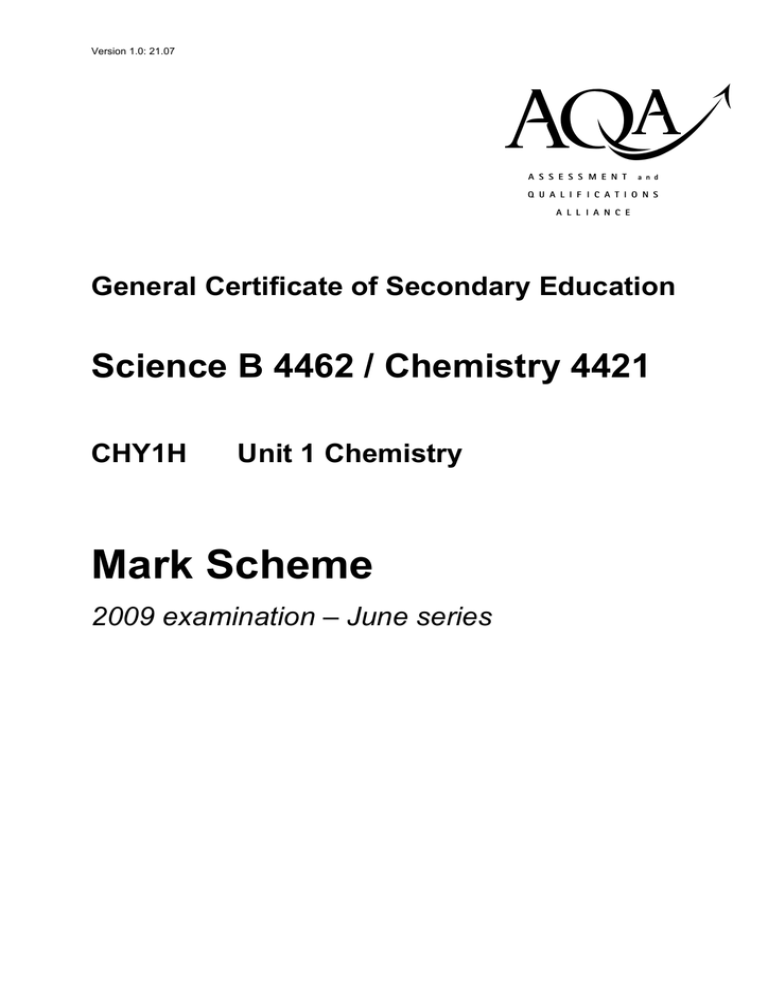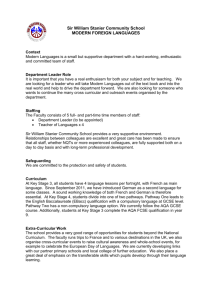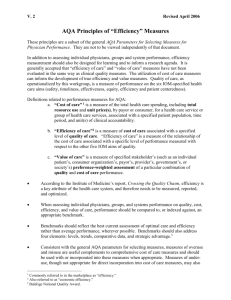
Version 1.0: 21.07
abc
General Certificate of Secondary Education
Science B 4462 / Chemistry 4421
CHY1H
Unit 1 Chemistry
Mark Scheme
2009 examination – June series
Mark schemes are prepared by the Principal Examiner and considered, together with the
relevant questions, by a panel of subject teachers. This mark scheme includes any
amendments made at the standardisation meeting attended by all examiners and is the scheme
which was used by them in this examination. The standardisation meeting ensures that the
mark scheme covers the candidates’ responses to questions and that every examiner
understands and applies it in the same correct way. As preparation for the standardisation
meeting each examiner analyses a number of candidates’ scripts: alternative answers not
already covered by the mark scheme are discussed at the meeting and legislated for. If, after
this meeting, examiners encounter unusual answers which have not been discussed at the
meeting they are required to refer these to the Principal Examiner.
It must be stressed that a mark scheme is a working document, in many cases further
developed and expanded on the basis of candidates’ reactions to a particular paper.
Assumptions about future mark schemes on the basis of one year’s document should be
avoided; whilst the guiding principles of assessment remain constant, details will change,
depending on the content of a particular examination paper.
Further copies of this Mark Scheme are available to download from the AQA Website: www.aqa.org.uk
Copyright © 2009 AQA and its licensors. All rights reserved.
COPYRIGHT
AQA retains the copyright on all its publications. However, registered centres for AQA are permitted to copy material
from this booklet for their own internal use, with the following important exception: AQA cannot give permission to
centres to photocopy any material that is acknowledged to a third party even for internal use within the centre.
Set and published by the Assessment and Qualifications Alliance.
The Assessment and Qualifications Alliance (AQA) is a company limited by guarantee registered in England and Wales (company number 3644723) and a registered charity (registered charity number 1073334).
Registered address: AQA, Devas Street, Manchester M15 6EX
Dr Michael Cresswell Director General
Science B / Chemistry CHY1H – AQA GCSE Mark Scheme 2009 June Series
MARK SCHEME
Information to Examiners
1.
General
The mark scheme for each question shows:
•
•
•
•
the marks available for each part of the question
the total marks available for the question
the typical answer or answers which are expected
extra information to help the Examiner make his or her judgement and help to
delineate what is acceptable or not worthy of credit or, in discursive answers, to give
an overview of the area in which a mark or marks may be awarded.
The extra information is aligned to the appropriate answer in the left-hand part of the
mark scheme and should only be applied to that item in the mark scheme.
At the beginning of a part of a question a reminder may be given, for example:
where consequential marking needs to be considered in a calculation;
or the answer may be on the diagram or at a different place on the script.
In general the right hand side of the mark scheme is there to provide those extra details
which confuse the main part of the mark scheme yet may be helpful in ensuring that
marking is straightforward and consistent.
2.
3.
Emboldening
2.1
In a list of acceptable answers where more than one mark is available ‘any two
from’ is used, with the number of marks emboldened. Each of the following lines
is a potential mark.
2.2
A bold and is used to indicate that both parts of the answer are required to award
the mark.
2.3
Alternative answers acceptable for a mark are indicated by the use of or.
(Different terms in the mark scheme are shown by a / ; eg allow smooth / free
movement.)
Marking points
3.1
Marking of lists
This applies to questions requiring a set number of responses, but for which
candidates have provided extra responses. The general principle to be followed
in such a situation is that ‘right + wrong = wrong’.
Each error/contradiction negates each correct response. So, if the number of
error/contradictions equals or exceeds the number of marks available for the
question, no marks can be awarded.
However, responses considered to be neutral (indicated as * in example 1) are
not penalised.
3
Science B / Chemistry CHY1H – AQA GCSE Mark Scheme 2009 June Series
Example 1: What is the pH of an acidic solution? (1 mark)
Candidate
Response
1
2
3
4
4,8
green, 5
red*, 5
red*, 8
Marks
awarded
0
0
1
0
Example 2: Name two planets in the solar system. (2 marks)
Candidate
1
2
3.2
Response
Pluto, Mars, Moon
Pluto, Sun, Mars,
Moon
Marks awarded
1
0
Use of chemical symbols / formulae
If a candidate writes a chemical symbol / formula instead of a required chemical
name, full credit can be given if the symbol / formula is correct and if, in the
context of the question, such action is appropriate.
3.3
Marking procedure for calculations
Full marks can be given for a correct numerical answer, as shown in the column
‘answers’, without any working shown.
However if the answer is incorrect, mark(s) can be gained by correct
substitution / working and this is shown in the ‘extra information’ column;
3.4
Interpretation of ‘it’
Answers using the word ‘it’ should be given credit only if it is clear that the ‘it’
refers to the correct subject.
3.5
Errors carried forward
Any error in the answers to a structured question should be penalised once only.
Papers should be constructed in such a way that the number of times errors can
be carried forward are kept to a minimum. Allowances for errors carried forward
are most likely to be restricted to calculation questions and should be shown by
the abbreviation e.c.f. in the marking scheme.
3.6
Phonetic spelling
The phonetic spelling of correct scientific terminology should be credited unless
there is a possible confusion with another technical term.
3.7
Brackets
(…..) are used to indicate information which is not essential for the mark to be
awarded but is included to help the examiner identify the sense of the answer
required.
4
Science B / Chemistry CHY1H – AQA GCSE Mark Scheme 2009 June Series
CHY1H
Question 1
question
answers
extra information
mark
1(a)(i)
3 / three
1
1(a)(ii)
5 / five
1
any one from:
1
1(b)
•
less / no transport
•
less / no (fossil) fuel used
accept less / no distance
ignore references to carbon dioxide /
carbon emissions
1(c)(i)
carbon dioxide / CO 2
for a correct emission
1
(causes) global warming / climate
change / greenhouse gas
explanation must be correct for
named emission
1
ignore ozone layer
or
(cement) particles / smoke
(1)
(causes) asthma / dust /
(global) dimming
(1)
accept breathing problems
or
sulfur dioxide / SO 2 /
nitrogen oxides / NO x
(causes) acid rain
(1)
(1)
do not accept nitrogen or water
vapour for emissions
do not accept no named emission
Question 1 continues on the next page…
5
Science B / Chemistry CHY1H – AQA GCSE Mark Scheme 2009 June Series
CHY1H
Question 1 Continued
question
1(c)(ii)
answers
absorb / trap / capture / filter / pass
through water / scrub / electrostatic
attraction
extra information
ignore condense / off setting /
different fuel
Total
mark
1
6
6
Science B / Chemistry CHY1H – AQA GCSE Mark Scheme 2009 June Series
CHY1H
Question 2
question
2(a)(i)
answers
calcium oxide / quicklime
extra information
allow calcium monoxide
mark
1
do not accept calcium dioxide
ignore chemical formulae
2(a)(ii)
2(b)(i)
any three from:
it = plaster
•
carbon dioxide / CO 2
•
(carbon dioxide) reacts
(with the calcium hydroxide /
slaked lime / plaster)
allow reaction 3 identified
do not allow incorrect reaction
ignore mixes, unless they state the
correct product
•
limestone / calcium carbonate /
Ca CO 3 forms
allow marble / chalk
•
water is lost / evaporates
allow moisture
ignore dries
as the amount / volume of sand
decreases the strength of the mortar
increases
accept as sand decreases the mortar is
stronger / harder to crack
3
1
allow as sand decreases the mortar
increases
allow converse
ignore references to height of metal
ball
Question 2 continues on the next page…
7
Science B / Chemistry CHY1H – AQA GCSE Mark Scheme 2009 June Series
CHY1H
Question 2 continued
question
2(b)(ii)
answers
extra information
any two from:
•
400 / 5th result is anomalous
•
the interval between the
others is similar or the
interval is about 6/7
•
he has only one set of results
mark
2
accept two results (36 and 37 /
400 and 500 / 4th and 5th) are almost
the same
accept result at 400 should be 42
allow the other results fit a pattern /
are on a straight line
allow he has only done it once
ignore reliable
Total
7
8
Science B / Chemistry CHY1H – AQA GCSE Mark Scheme 2009 June Series
CHY1H
Question 3
question
answers
extra information
mark
3(a)(i)
(gases from) volcanoes
3(a)(ii)
100
allow 99
1
3(a)(iii)
any two from:
they = plants
2
1
•
photosynthesis
•
carbon dioxide used
allow carbon dioxide decreased
•
oxygen produced
allow oxygen increased
ignore nitrogen / respiration
3(b)(i)
3(b)(ii)
1
any one from:
•
sea floor spreading
accept oceanic ridges / magnetic
stripes
•
periodic measurements between
continents
accept continents move a few
centimetres each year
•
evidence from rocks / fossils on
different continents
accept continents fit together
•
new mountain ranges
accept new islands
1
in the mantle
2
any two from:
•
convection (currents) /
movement
•
radioactivity / radioactive
decay / nuclear reactions
•
releases heat / thermal
energy
do not accept movement of the plates
accept heat from core
Total
8
9
Science B / Chemistry CHY1H – AQA GCSE Mark Scheme 2009 June Series
CHY1H
Question 4
question
4(a)(i)
answers
extra information
mark
reacts with carbon / C
accept burns / oxidises carbon
1
carbon dioxide / CO2 /
gas is formed / given off
accept carbon monoxide / CO
1
accept correctly balanced equation
for 2 marks
ignore state symbols
4(a)(ii)
change / improve properties
accept any specific property
1
accept to make alloys / special steels
ignore brittle
4(b)
2
any two from:
•
to conserve ores / iron
accept ores / iron are non-renewable /
non-sustainable
allow less quarrying / mining
•
to prevent the use of landfills
allow reduce waste
•
to conserve energy / fuel
accept fossil fuels are non-renewable
•
to reduce carbon /
carbon dioxide emissions
•
to meet EU / International
targets
ignore costs / demand
Total
5
10
Science B / Chemistry CHY1H – AQA GCSE Mark Scheme 2009 June Series
CHY1H
Question 5
question
answers
5(a)
yes (there is the general trend) ‘as the
iodine value increases the melting
point decreases’ or ‘as the hardness
decreases the mp decreases’
or
no melting points are in random
order / go up and down
one specific use of comparative data
from the table either showing the
trend or an anomaly
extra information
accept converse statement
mark
1
do not accept boiling point
can be gained from yes or no answer
1
ignore bp
5(b)
the iodine turns colourless
this would be difficult to see
(if the oil was dark coloured)
5(c)
5(d)
1
allow similar colour as iodine
or iodine is brown
(consumer may think that) the
company (scientists) would be biased
1
1
consumer more likely to trust
independent scientists
allow independent scientists not
biased
1
add (measured amount of) hydrogen
accept hydrogenation
1
2
any two from:
•
(nickel) catalyst
•
hot / 60oC temperature
•
hardened
accept add a hard / hydrogenated fat /
oil
or make an emulsion
Total
9
11
Science B / Chemistry CHY1H – AQA GCSE Mark Scheme 2009 June Series
CHY1H
Question 6
question
answers
extra information
mark
6(a)(i)
many ethene / molecules / monomers
accept double bonds open / break
1
join to form a long hydrocarbon /
chain / large molecule
accept addition polymerisation
1
ignore references to ethane
correct equation gains 2 marks
6(a)(ii)
(can be deformed but) return to their
original shape (when heated or
cooled)
6(a)(iii)
ignore ‘it remembers its shape’
1
it = PEX throughout
cross links / extra bonds in PEX
molecules / chains in PEX are held in
position
accept inter-molecular bonds
ignore inter-molecular forces
accept rigid structure
1
1
1
molecules / chains in PEX unable to
slide past each other / move
Question 6 continues on the next page…
12
Science B / Chemistry CHY1H – AQA GCSE Mark Scheme 2009 June Series
CHY1H
Question 6 Continued
question
6(b)
answers
any four from:
extra information
ignore costs / sustainability /
non-renewable
mark
4
allow less energy
•
less (hydrocarbon) fuels used
•
less / no electrical energy used
•
reduce carbon / carbon dioxide
emissions
•
reduce / no pollution by
sulfur dioxide / acid rain
•
continuous process
•
conserve copper which is running
out or only low-grade ores
available
•
reduce the amount of solid waste
rock that needs to be disposed
allow less waste
•
reduce the need to dig large holes
(to extract copper ores)
allow less mining
allow no electrolysis
allow less global warming
allow less / no transportation
Total
10
13






